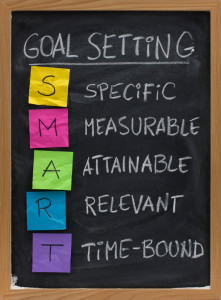 If you’re anything like me, you’ll sometimes get the feeling that life is kind of unfair. Genetics dictated that I was never going to be a Victoria’s Secret model. However, there are some things that we can all change; for example, it is my current lifestyle that stops me from, say, running a marathon or losing that stubborn last few pounds. By setting goals, we set a standard for the person we want to be or something we want to achieve, and instead of lamenting the fact that we were born ‘as we are’, we get up and we endeavour to fulfill these goals – however big or small they may be.
If you’re anything like me, you’ll sometimes get the feeling that life is kind of unfair. Genetics dictated that I was never going to be a Victoria’s Secret model. However, there are some things that we can all change; for example, it is my current lifestyle that stops me from, say, running a marathon or losing that stubborn last few pounds. By setting goals, we set a standard for the person we want to be or something we want to achieve, and instead of lamenting the fact that we were born ‘as we are’, we get up and we endeavour to fulfill these goals – however big or small they may be.
So, how can you dream big and still set realistic fitness goals? By learning how to accomplish things the SMART way. When trying to hone your goals – be they about weight loss, athletic accomplishments, helping others or whatever it may be that makes you feel great – keep in mind the following criteria. A goal must be:
- Specific: Make your goal specific, not vague or general. To set a specific goal you must answer the six ‘W’ questions (think GCSE English!): who, what, where, when, which and why. So, for example, a general goal would be, ‘get in shape’. But a specific goal would say, ‘I’ll join [X] gym and workout [Y] days a week’. Make your you know exactly what you’re aiming towards!
- Measurable – Establish concrete criteria for measuring progress toward the attainment of each goal you set. When you measure your progress – you stay on track, reach your target dates, and feel the sense of accomplishment that spurs you on to continued effort required to reach your goal. Try taking a notebook or diary to the gym so you can mark down your progress over a length of time, for example, or make sure you run a little bit further every day.
- Attainable – Identify the goals that are most important to you and begin to establish ways you can make them come true. Over time, you will develop the attitudes, abilities and skills to reach them; you begin seeing previously overlooked opportunities to bring yourself closer to the achievement of your goals. You can attain most any goal you set when you plan your steps wisely and establish a time frame that allows you to carry out those steps. Goals that may have seemed far away and out of reach eventually move closer and become attainable, not because your goals shrink, but because you grow and expand to match them. When you list your goals you build your self-image. You see yourself as worthy of these goals, and develop the traits and personality that allow you to possess them.
- Realistic– To be realistic, a goal must represent an objective toward which you are both willing and able to work. A goal can be both high and realistic; you are the only one who can decide just how high your goal should be. But be sure that every goal represents substantial progress. A high goal is frequently easier to reach than a low one because a low goal exerts low motivational force. Don’t settle for a 5k, run a marathon!
- Timely – A goal should be grounded within a time frame. With no time frame tied to it there’s no sense of urgency. If you want to lose 10 lbs, when do you want to lose it by? ‘Someday’ is no good to you. But if you anchor it within a timeframe, then you’ve set your unconscious mind into motion to begin working on the goal.
 Supplement Judge Unbiased Supplement Reviews – Do they really work??
Supplement Judge Unbiased Supplement Reviews – Do they really work??





If you’d like a tool for setting your goals, you can use this web application:
GTD Agenda.com
You can use it to manage your goals, projects and tasks, set next actions and contexts, use checklists, and a calendar.
Syncs with Evernote and Google Calendar, and also comes with mobile version, and Android and iPhone apps.